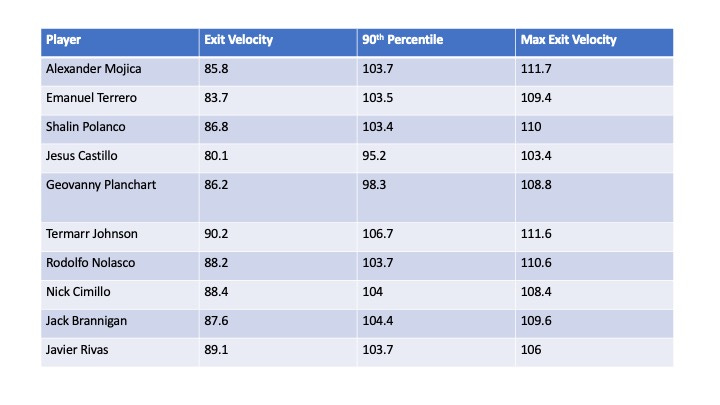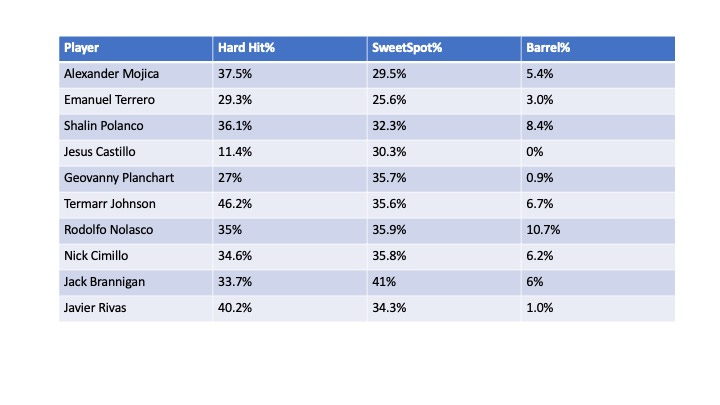Bradenton Marauders First Half Exit Velocity Numbers
Taking a deep dive at the first half of the season for Bradenton Marauders hitters.
While exit velocity can still be a hotly debated topic in the baseball world, it really is just a way to put a numeric value next to the old ‘he hits the ball hard’ observation that people have been making in the sport for years.
It isn’t a clear cut path to success, but there is undeniable evidence that hitting the ball harder generally leads to more hits.
Taking a look at Bradenton this season, there are several intriguing names on the hitting side of things to play for the Marauders. Obviously being on the younger side of things, their bodies are still growing, so in a lot of cases they should tap into a little more power as things go on. So, if they are already hitting the ball fairly hard, that only bodes well for their future as they finish growing into their body.
There are 10 players to have at least 80 batted ball events this season for the Marauders. Here’s a look at how they stack up when it comes to several key exit velocity metrics.
Exit Velocity
When you factor in an entire season worth of data, average exit velocity is a good indicator of how consistently hard a hitter was making contact. Still, using the 90th percentile does a good job of eliminating a bigger outlier in a player’s data, pointing to what they are more capable of doing. Max Exit Velocity obviously gives you an idea what a player is fully capable of on an extreme basis.
We can see why Termarr Johnson was such a highly regarded prospect in the draft, especially as a hitter. He spent the first part of the season as a 18-year-old hitter in Single-A, and was still putting up above-average exit velocity numbers.
Even if his frame doesn’t allow for him to fill out too much more, the power potential is already there to be an above-average power hitter, especially at second base, at the major league level.
Last year, the major league 90th percentile mark for exit velocity was 103.7 mph, with six of the 10 players listed meeting that mark. Advanced hitters coming from the college ranks like Jack Brannigan and Nick Cimillo were less of a surprise than some of the younger names like Alexander Mojica or Javier Rivas.
Enmanuel Terrero has been one of the true pop up prospects in the system so far for the Pirates, and is a good example of how valuable using the 90th percentile can be. At first glance an 83-mph EV isn’t generally anything to write home about, but despite that he’s right at major league average for 90th percentile.
Looking at his batted ball data, there are several instances of BBE that are seriously driving down his exit velocity, outside of those, he’s been driving the ball fairly well.
Hitting Rates
One last set of data out of Bradenton, Hard Hit%, SweetSpot%, and Barrel%. Hard Hit tracks how often the player has a BBE of 95 mph+, Sweet Spot tracks the launch angle (in between eight and 32 degrees) and barrel is a combination of the two.
The number that immediately jumps off the chart is the near 50% hard hit rate by Termarr. Out of all his BBE, almost half have been 95 mph or higher. He’s barreling things up as well, with a very respectable 6.7% rate as well.
You can see the potential damage that Rivas could do if he could square things up more (that’s even more true with his struggles against breaking pitches), as a 40.2% hard hit rate is great, but has just a 1% barrel rate.
Shalin Polanco is among the leaders in the Florida State League when it comes to home runs, and you can see why with his metrics. For someone who is 19-years-old in his first full season of baseball, he’s showing plenty of power potential going forward. Rodolfo Nolasco was hitting the ball hard at the time of his injury last year, and has picked up where he has left off. His barrel rate would put him in the Top-50 in the majors among hitters with at least 100 BBE.
Advanced metrics should never be a final be all, say all when it comes to evaluating players, especially prospects. Nolasco and Polanco are destroying the baseball right now, but also striking out over 30% of the time in Single-A, not the greatest recipe for long-term success moving up the ladder.
It’s already hard enough to get hits when the ball is put in play, striking out a lot limits you even further. Having strong exit velocity numbers can help counteract that, as statistically it improves your odds of getting on base, but again, it’s not the entire picture when it comes to hitting.




This content is so cool! Love that we can get these batted ball metrics, and termarr really does look like a true standout with stuff like this, definitely makes me worry much less about early season noise
What does 90th percentile mean? I get the rest of them.
And, other than Termarr, with all of this data, who should we get excited about? Do we really have that many good hitters at Bradenton?
Thx